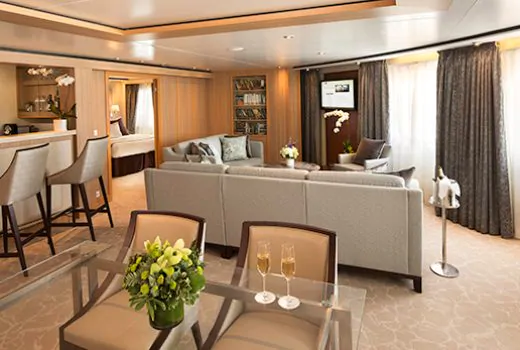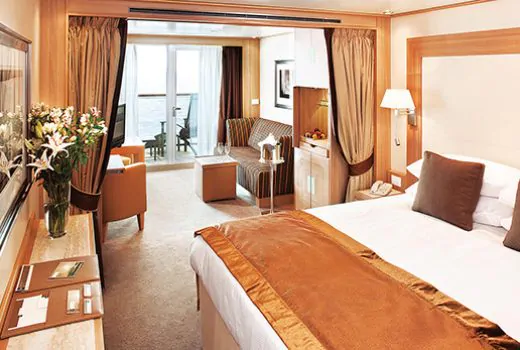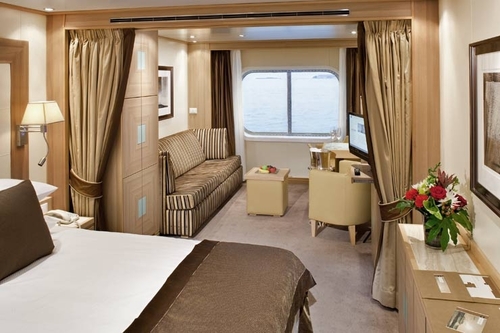Spain, Portugal & Mediterranean Jewels
- 15 Nov ‘26
- 20 nights
- Departing from Civitavecchia (Rome)
- Seabourn Sojourn
-
Inside price fromCall for price
-
Outside price from$12,689*/pp
-
Balcony price from$14,759*/pp
-
Suite price from$27,899*/pp
YOUR ITINERARY
Civitavecchia (Rome), Italy - Bonifacio, Corsica, France - Cagliari, Sardinia, Italy - Trapani, Sicily, Italy - Valletta, Malta - Mgarr (Victoria), Malta - La Goullette, Tunisia - Mahon, Spain - Palma de Mallorca, Spain - Barcelona, Spain - Valencia, Spain - Cartagena, Spain - Malaga, Spain - Gibraltar, British Territory - Tangier, Morocco - Cadiz (Seville), Spain - Leixoes (Porto), Portugal - Leixoes (Porto), Portugal - Lisbon, Portugal
Originally built by Emperor Trajan who had a villa here, ...
Originally built by Emperor Trajan who had a villa here, Civitavecchia has flourished as a major port for Rome since the 13th century. Today it is an important ferry terminal and for many travelers the gateway to the Eternal City, Rome. The Renaissance fortifications that surround the harbor area were begun by Bramante and completed by Michelangelo in 1535.
The scented isle of Corsica, birthplace of Napoleon,...
The scented isle of Corsica, birthplace of Napoleon, was controlled for centuries by Genoa and did not become a region of France until 1768. As late as the last century, the rugged island was still a haven for bands of brigands. Today, the island’s inviting beaches and scenic beauty attract an increasing number of tourists hoping to escape the much more hectic pace of the Riviera. Bonifacio, perched at the top of towering white cliffs, is a striking sight from the sea. Watch for the 15th-century staircase carved into the cliff face which runs right down to the water’s edge as you approach the harbor.
The pleasingly green, quiet island of Sardinia offer...
The pleasingly green, quiet island of Sardinia offers the visitor scenic beauty and a relaxed lifestyle. Cagliari, the island’s capital, features handsome Italianate architecture and several churches reflecting a variety of influences. Impressive views are provided by the city’s hillsides, with one of the best panoramas available from the old walls of Terrazzo Umberto. The island’s natural charm has attracted pleasure-seekers to the Costa Smeralda since the Aga Khan sought shelter ashore from a storm at sea.
Bright stone buildings mark the rambling layout and baroq...
Bright stone buildings mark the rambling layout and baroque architecture of Trapani. Extending out into the sea, the towns characteristic shape of a scythe, frames the majestic Tower of Ligny, which rises from its most extreme point. Originally under Arab dominion, Trapani was a blossoming center for the production of salt, tuna, and coral. The city became famous throughout the Old World in the 16th century, when the work of Trapanese coral artisans was revealed. Their gorgeous collection of works in coral is preserved in the Pepoli Museum.
Occupied successively by the Phoenicians, Greeks, Carthaginia...
Occupied successively by the Phoenicians, Greeks, Carthaginians, Romans, Arabs, French and British, Malta has been of strategic importance throughout history. A British Crown Colony until 1964, Malta received the George Cross for its valiant resistance to German occupation in WWII. The island’s rich heritage is reflected in the architecture of Valletta, the current capital, and Medina, the capital until 1565. In Valletta the Knights of St. John built such masterpieces as St. John’s Co-Cathedral and the Palace of the Grand Masters, along with the fortifications that guard the town’s magnificent harbors.
A port not often visited by cruise ships, being more...
A port not often visited by cruise ships, being more accustomed to welcoming fishing boats and private yachts. Malta’s smaller sister-isle has a lot of charm to offer. Villages such as Mgarr all boast tall, elaborately carved churches, the result of a combination of fine-grained, easily carved stone, time, and stonemasons whose skill is matched only by their religious devotion. The city of Victoria was so named to honor the British queen’s Diamond jubilee.
La Goulette, known in Arabic as Halq al-Wadi, is the port of Tun...
La Goulette, known in Arabic as Halq al-Wadi, is the port of Tunis, the capital of Tunisia. The Kasbah fortress was built in 1535 by Charles I of Spain but was captured by the Ottoman Turks in 1574
Mahon is the capital of Menorca, second largest of the Ba...
Mahon is the capital of Menorca, second largest of the Balearic Islands. It stands out from the others because of the abundance of prehistoric structures, and because its culture was influenced by British occupation in the 18th century. The people who built the prehistoric constructions are believed to have been responsible for similar works in Sardinia, and for Stonehenge in England. Believed to have been founded by the Carthaginian General Mago, Mahon was held by the Moors from the 8th to the 13th century and in turn occupied by the English, the French and the Spanish. Mahon was finally ceded to Spain by the Treaty of Amiens in 1802.
Spain’s Balearic Islands are among Europe’s mos...
Spain’s Balearic Islands are among Europe’s most popular resort destinations. Mallorca is the largest and most developed of these islands. Rome and Carthage battled over this territory and portions of ancient Roman constructions still remain. Founded almost 2,100 years ago, the city of Palma de Mallorca, the island’s busy capital city boasts a considerable store of history. Mallorca welcomes its visitors to an island, which can be both exciting and tranquil. The abundant sightseeing and sunshine are yours to enjoy.
Barcelona, the capital of Catalonia, is said to have been founde...
Barcelona, the capital of Catalonia, is said to have been founded by the Phoenicians, and was once the rival of the powerful states of Venice and Genoa for control of the Mediterranean trade. Today, it is Spain’s second largest city and has long rivaled, even surpassed Madrid in industry and commerce. The medieval atmosphere of the Gothic Quarter and the elegant boulevards combine to make the city one of Europe’s most beautiful. Barcelona’s active cultural life and heritage brought forth such greats as the architect Antonio Gaudi, the painter Joan Miro, and Pablo Picasso, who spent his formative years here. Other famous native Catalan artists include cellist Pau Casals, surrealist Salvador Dali, and opera singers Montserrat Caballe and Josep Carreras. Barcelona accomplished a long-cherished goal with the opportunity to host the Olympics in 1992. This big event prompted a massive building program and created a focal point of the world’s attention.
Valencia is located in the middle of Europe’s most dens...
Valencia is located in the middle of Europe’s most densely developed agricultural region. Originally a Greek settlement, the town was taken over by Romans in 138 BC and turned into a retirement town for old soldiers. The Moors controlled the land for 500 years, and this fertile plain, which today yields three to four crops, was considered to be heaven on earth. El Cid conquered Valencia for Spain in 1094, but it fell back into Moorish hands after his death. Incorporated into Spain in the 15th century, Valencia remains the nation’s breadbasket.
Founded by Carthaginians in the third century BC,...
Founded by Carthaginians in the third century BC, this ancient Mediterranean port city exemplifies the region’s tumultuous history. Romans, Visigoths, Castilians and Moors have all left their marks. Under King Philip II, Cartagena’s naturally deep, sheltered harbor was developed into the nation’s premier naval base, a position it still enjoys today. Ancient ramparts remain, as does a lighthouse erected in Moorish times.
Often little more than a gateway to the Costa del Sol for su...
Often little more than a gateway to the Costa del Sol for sun-seeking vacationers, Malaga is a most interesting city in its own right. First settled by the Phoenicians, Malaga was held by virtually every ruling power in the Mediterranean at one time or another. Two Moorish fortresses, the 11th-century Alcazaba and the 14th-century Castillo de Gibralfaro still stand sentry above the harbor. Malaga was the birthplace of Pablo Picasso as well as the Malaguena style of flamenco. During your time here, you may wish to sample some of the sweet Malaga wine and excellent tapas for which the city is noted.
With Spain to the north and Morocco to the south, Gib...
With Spain to the north and Morocco to the south, Gibraltar is the famous promontory dominating the narrow entrance to the Mediterranean. Its position led to its seizure by the Moors in 711 as a prelude to the conquest of Spain. The Moorish influence includes the name Gibraltar, a corruption of “Jebel Tariq” (Tariq’s Mountain), named after the Moorish commander Tariq who built the first fortification. In ancient times Gibraltar was regarded as one of the two Pillars of Hercules, which marked the western limits of the known world. Known commonly as “The Rock,” Gibraltar is full of natural caves and manmade tunnels. The Rock itself, composed of limestone and gray marble, is geographically part of the Iberian Peninsula. Politically, the British have controlled Gibraltar for over two centuries. This tiny self-governing British Colony welcomes you to enjoy its historical sites, magnificent views, beautiful beaches and duty free shops.
Situated just across the narrow Strait of Gibraltar from Europe...
Situated just across the narrow Strait of Gibraltar from Europe, Tangier has long comprised a hybrid culture that is nearly as European as it is African. Standing atop Cap Spartel, one can gaze down on the place where the Atlantic meets the Mediterranean. The “Hollywood” district where the foreign embassies have traditionally been located reflects the European influence. But ascending the hill above the waterfront, one enters the narrow, winding alleys of the Kasbah, the city’s oldest, most Moroccan section. Down the coast, nearby Tetouan retains a nearly untouched walled medina, with sections originally occupied by Andalusian, Berber and Jewish populations. It is small enough that visitors can explore it without risking becoming lost, making it a perfect choice as a UNESCO World Heritage Site.
To taste the true flavor of this ancient port city, one ...
To taste the true flavor of this ancient port city, one should stroll its seaside promenade, pausing to rest beneath the huge banyan trees. The narrow, winding streets of the old town fan out from the port, leading you to sunny, palm-lined plazas. Visit the Catedral Nueva (New Cathedral), begun in the early 1800s but not completed for 116 years. Its dramatic, golden dome rises over a striking interior. For those who enjoy people-watching as much as sightseeing, the seafood restaurants along the eastern edge of the port provide the ideal setting.
The commercial center of northern Portugal and hub of...
The commercial center of northern Portugal and hub of the port wine trade, Porto is a gracious, cosmopolitan city noted for its 12th century cathedral and medieval churches, picturesque narrow streets and wine lodges at Vila Nova de Gaia. It is clustered on hills overlooking a river, and is a northern European style city with granite church towers, narrow streets and hidden Baroque treasures.
The commercial center of northern Portugal and hub of ...
The commercial center of northern Portugal and hub of the port wine trade, Porto is a gracious, cosmopolitan city noted for its 12th century cathedral and medieval churches, picturesque narrow streets and wine lodges at Vila Nova de Gaia. It is clustered on hills overlooking a river, and is a northern European style city with granite church towers, narrow streets and hidden Baroque treasures.
The great period of “the Discoveries” accounted ...
The great period of “the Discoveries” accounted for phenomenal wealth brought back from India, Africa and Brazil by the great Portuguese navigators. Gold, jewels, ivory, porcelain and spices helped finance grand new buildings and impressive monuments in Lisbon, the country’s capital city. As you sail up the Tagus River, be on deck to admire Lisbon’s panorama and see some of the great monuments lining the river. Lisbon is one of Europe’s smallest capital cities but considered by many visitors to be one of the most likeable. Spread over a string of seven hills, the city offers a variety of faces, including a refreshing no-frills simplicity reflected in the people as they go unhurriedly through their day enjoying a hearty and delicious cuisine accompanied by the country’s excellent wines.
YOUR SHIP - The Seabourn Sojourn
Seabourn Sojourn enchants her guests with an array of public areas scaled to encourage a relaxed sociability. One of the most unusual features of Seabourn Sojourn and her sisters is Seabourn Square, an ingenious “living room” that replaces the traditional cruise ship lobby with a welcoming lounge filled with easy chairs, sofas and cocktail tables; making it more inviting and relaxing on a small ship cruise. An enclave in its center houses knowledgeable concierges discreetly seated at individual desks.
Seabourn Sojourn enchants her guests with an array of public areas scaled to encourage a relaxed sociability. One of the most unusual features of Seabourn Sojourn and her sisters is Seabourn Square, an ingenious “living room” that replaces the traditional cruise ship lobby with a welcoming lounge filled with easy chairs, sofas and cocktail tables; making it more inviting and relaxing on a small ship cruise. An enclave in its center houses knowledgeable concierges discreetly seated at individual desks.
Beauty Salon
Facial Treatments
Massage
Sauna
Spa
Swimming Pool
Thalassotherapy Pool
Whirlpool
In-Suite Service
Patio Grill
Sky Bar
The Colonnade
The Restaurant
The Restaurant 2
Gym
Sports Deck
Description
Seabourn Sojourn enchants her guests with an array of public areas scaled to encourage a relaxed sociability. One of the most unusual features of Seabourn Sojourn and her sisters is Seabourn Square, an ingenious “living room” that replaces the traditional cruise ship lobby with a welcoming lounge filled with easy chairs, sofas and cocktail tables; making it more inviting and relaxing on a small ship cruise. An enclave in its center houses knowledgeable concierges discreetly seated at individual desks.
Relaxation
Beauty Salon
Facial Treatments
Massage
Sauna
Spa
Swimming Pool
Thalassotherapy Pool
Whirlpool
Food and Drink
In-Suite Service
Patio Grill
Sky Bar
The Colonnade
The Restaurant
The Restaurant 2
Fitness
Gym
Sports Deck
STATEROOMS

suite

balcony


